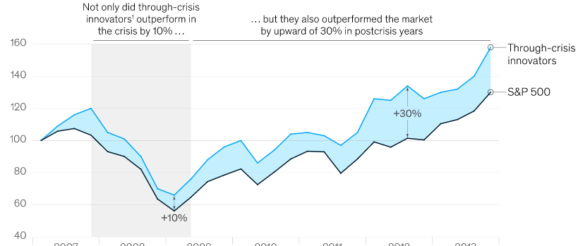What the pandemic has meant for innovation in healthcare | World Economic Forum

Medicine is a living science that prides itself on continual discovery. In recent years, healthcare innovators have brought us artificial-intelligence algorithms that arguably read chest X-rays as well as or better than radiologists, inexpensive genomic sequencing that can guide personalized cancer treatments, and vast improvements in population health management through big data and analytics, to name just a few examples.
Setting a bold but plausible aspiration—both during this crisis and for the period after—and cascading it to all relevant stakeholders is considered critical to driving innovation. At the beginning of the pandemic, that aspiration was clear: flatten the curve. Healthcare systems quantified it locally based on available hospital and ICU beds and communicated it to the public so everyone, from epidemiologists to policy makers to citizens, understood the objective. That aspiration then fundamentally changed how we worked, shopped, and socialized.
For example, as of September, there are more than 275 COVID-19 vaccine candidates being pursued with more than 40 in clinical studies and another 20 or so poised to enter human trials before year-end. Many of these efforts are new partnerships and collaborations. The lines between competitors and allies may also be blurring with new partnerships forming to develop treatments, such as between Pfizer and BioNTech, and manufacture them (GlaxoSmithKline, for example). These new collaborations may augur well for the continued development of creative partnerships and new business models, as well as the future of medical R&D in general.
The high human and economic costs associated with COVID-19 make it more important than ever to rapidly accelerate and scale medical innovations. Healthcare leaders should consider providing the tools, processes, and capabilities their teams will likely need to move quickly while ensuring that patient safety and quality of care remain central. In addition, organizations should consider the groundwork needed to be able to quickly scale the development of promising solutions internally and their distribution throughout health systems and across regions. That will likely include making investments at risk—that is, making investments without knowing that the solutions will work.
Healthcare providers have already shown how rapidly they can expand their capacity to care for the sick. In February, China opened two prefabricated hospitals in just over a week,8 and the United Kingdom’s National Health Service opened London’s Nightingale hospital in nine days.9
Shanghai launched 11 online hospitals affiliated with offline facilities during the outbreak, with 14,000 visits to these internet hospitals in just two months. Many manufacturers have also successfully reconfigured assembly lines to produce medical products.10 These examples highlight just how much acceleration may be possible when timelines are urgent and aspirations are clear. Healthcare players could consider adopting some of the flexible approaches introduced at the height of the crisis to areas that have traditionally followed slow, gated processes, such as the construction of hospitals.
As they pursue promising innovations on short timelines, healthcare organizations will likely face gaps in capabilities and capacity. To address them, they should consider extending their efforts beyond their own walls to external partners. Conquering COVID-19 is now a central priority not just for healthcare companies but also for public and academic institutions and nontraditional players such as technology businesses. But such networks should consider coherent strategies to guide them.
During common crises, coalitions often thrive. As we mentioned above, traditional competitors are becoming collaborators in the race to develop therapeutics that can help manage COVID-19. Collaboration has also taken root in the academic and institutional sphere. Johns Hopkins, Harvard, McGill, and the Swiss Data Science Center have formed the COVID-19 Collaboration Platform to share randomized clinical trial protocols with the aim of speeding up such trials and raising their accuracy. Such platforms can enable researchers to not only better address the COVID-19 pandemic but future global health emergencies.11
